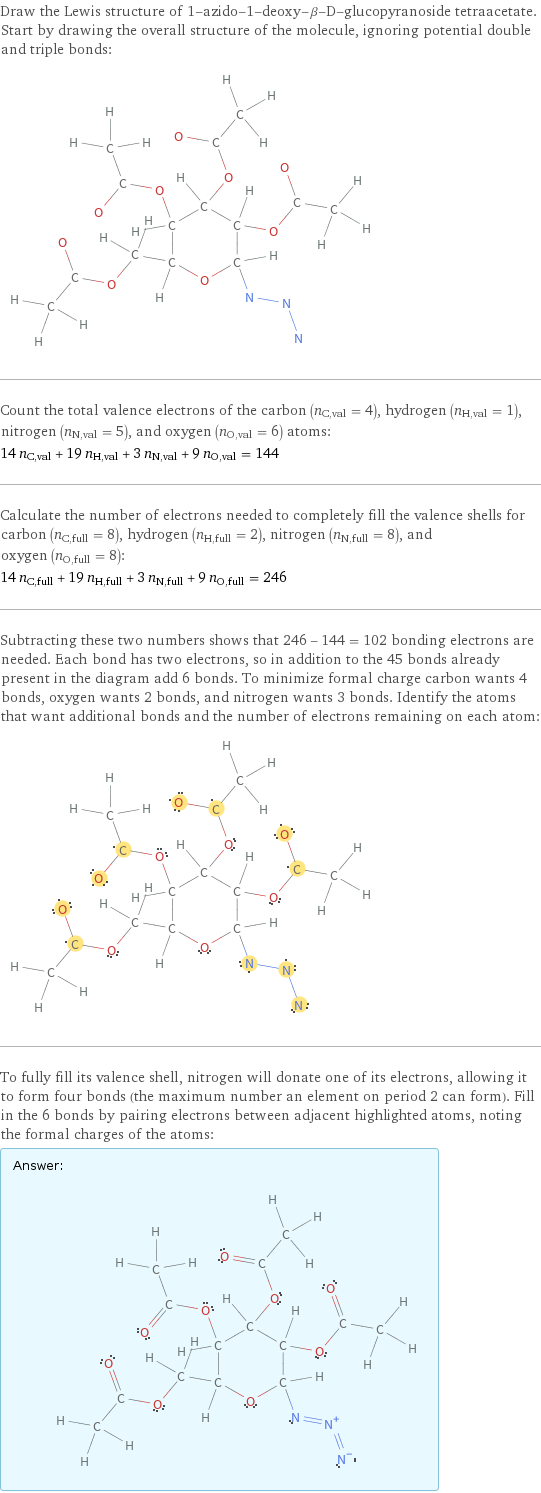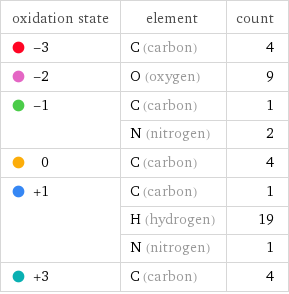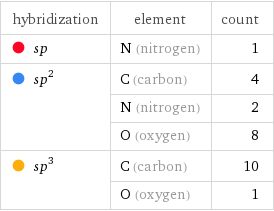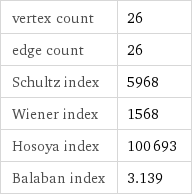Input interpretation

1-azido-1-deoxy-β-D-glucopyranoside tetraacetate
Basic properties
![molar mass | 373.3 g/mol formula | C_14H_19N_3O_9 empirical formula | C_14O_9N_3H_19 SMILES identifier | CC(=O)OC[C@@H]1[C@H]([C@@H]([C@H]([C@H](N=[N+]=[N-])O1)OC(=O)C)OC(=O)C)OC(=O)C InChI identifier | InChI=1/C14H19N3O9/c1-6(18)22-5-10-11(23-7(2)19)12(24-8(3)20)13(25-9(4)21)14(26-10)16-17-15/h10-14H, 5H2, 1-4H3/t10-, 11-, 12+, 13-, 14-/m1/s1 InChI key | NHNYHKRWHCWHAJ-RKQHYHRCSA-N](../image_source/f825888c8aa7886887190aee33024d1e.png)
molar mass | 373.3 g/mol formula | C_14H_19N_3O_9 empirical formula | C_14O_9N_3H_19 SMILES identifier | CC(=O)OC[C@@H]1[C@H]([C@@H]([C@H]([C@H](N=[N+]=[N-])O1)OC(=O)C)OC(=O)C)OC(=O)C InChI identifier | InChI=1/C14H19N3O9/c1-6(18)22-5-10-11(23-7(2)19)12(24-8(3)20)13(25-9(4)21)14(26-10)16-17-15/h10-14H, 5H2, 1-4H3/t10-, 11-, 12+, 13-, 14-/m1/s1 InChI key | NHNYHKRWHCWHAJ-RKQHYHRCSA-N
Lewis structure

Draw the Lewis structure of 1-azido-1-deoxy-β-D-glucopyranoside tetraacetate. Start by drawing the overall structure of the molecule, ignoring potential double and triple bonds: Count the total valence electrons of the carbon (n_C, val = 4), hydrogen (n_H, val = 1), nitrogen (n_N, val = 5), and oxygen (n_O, val = 6) atoms: 14 n_C, val + 19 n_H, val + 3 n_N, val + 9 n_O, val = 144 Calculate the number of electrons needed to completely fill the valence shells for carbon (n_C, full = 8), hydrogen (n_H, full = 2), nitrogen (n_N, full = 8), and oxygen (n_O, full = 8): 14 n_C, full + 19 n_H, full + 3 n_N, full + 9 n_O, full = 246 Subtracting these two numbers shows that 246 - 144 = 102 bonding electrons are needed. Each bond has two electrons, so in addition to the 45 bonds already present in the diagram add 6 bonds. To minimize formal charge carbon wants 4 bonds, oxygen wants 2 bonds, and nitrogen wants 3 bonds. Identify the atoms that want additional bonds and the number of electrons remaining on each atom: To fully fill its valence shell, nitrogen will donate one of its electrons, allowing it to form four bonds (the maximum number an element on period 2 can form). Fill in the 6 bonds by pairing electrons between adjacent highlighted atoms, noting the formal charges of the atoms: Answer: | |
Quantitative molecular descriptors

longest chain length | 11 atoms longest straight chain length | 4 atoms longest aliphatic chain length | 2 atoms aromatic atom count | 0 atoms H-bond acceptor count | 11 atoms H-bond donor count | 0 atoms
Elemental composition

Find the elemental composition for 1-azido-1-deoxy-β-D-glucopyranoside tetraacetate in terms of the atom and mass percents: atom percent = N_i/N_atoms × 100% mass percent = (N_im_i)/m × 100% Plan: • Write the chemical formula and gather atomic masses from the periodic table. • Determine values for N_i, m_i, N_atoms and m using these items. • Finally, compute the percents and check the results. Write the chemical formula: C_14H_19N_3O_9 Use the chemical formula to count the number of atoms, N_i, for each element and find the total number of atoms, N_atoms, per molecule: | number of atoms C (carbon) | 14 O (oxygen) | 9 N (nitrogen) | 3 H (hydrogen) | 19 N_atoms = 14 + 9 + 3 + 19 = 45 Divide each N_i by N_atoms to calculate atom fractions. Then use the property that atom fractions must sum to one to check the work: | number of atoms | atom fraction C (carbon) | 14 | 14/45 O (oxygen) | 9 | 9/45 N (nitrogen) | 3 | 3/45 H (hydrogen) | 19 | 19/45 Check: 14/45 + 9/45 + 3/45 + 19/45 = 1 Compute atom percents using the atom fractions: | number of atoms | atom percent C (carbon) | 14 | 14/45 × 100% = 31.1% O (oxygen) | 9 | 9/45 × 100% = 20.0% N (nitrogen) | 3 | 3/45 × 100% = 6.67% H (hydrogen) | 19 | 19/45 × 100% = 42.2% Look up the atomic mass, m_i, in unified atomic mass units, u, for each element in the periodic table: | number of atoms | atom percent | atomic mass/u C (carbon) | 14 | 31.1% | 12.011 O (oxygen) | 9 | 20.0% | 15.999 N (nitrogen) | 3 | 6.67% | 14.007 H (hydrogen) | 19 | 42.2% | 1.008 Multiply N_i by m_i to compute the mass for each element. Then sum those values to compute the molecular mass, m: | number of atoms | atom percent | atomic mass/u | mass/u C (carbon) | 14 | 31.1% | 12.011 | 14 × 12.011 = 168.154 O (oxygen) | 9 | 20.0% | 15.999 | 9 × 15.999 = 143.991 N (nitrogen) | 3 | 6.67% | 14.007 | 3 × 14.007 = 42.021 H (hydrogen) | 19 | 42.2% | 1.008 | 19 × 1.008 = 19.152 m = 168.154 u + 143.991 u + 42.021 u + 19.152 u = 373.318 u Divide the mass for each element by m to calculate mass fractions. Then use the property that mass fractions must sum to one to check the work: | number of atoms | atom percent | mass fraction C (carbon) | 14 | 31.1% | 168.154/373.318 O (oxygen) | 9 | 20.0% | 143.991/373.318 N (nitrogen) | 3 | 6.67% | 42.021/373.318 H (hydrogen) | 19 | 42.2% | 19.152/373.318 Check: 168.154/373.318 + 143.991/373.318 + 42.021/373.318 + 19.152/373.318 = 1 Compute mass percents using the mass fractions: Answer: | | | number of atoms | atom percent | mass percent C (carbon) | 14 | 31.1% | 168.154/373.318 × 100% = 45.04% O (oxygen) | 9 | 20.0% | 143.991/373.318 × 100% = 38.57% N (nitrogen) | 3 | 6.67% | 42.021/373.318 × 100% = 11.26% H (hydrogen) | 19 | 42.2% | 19.152/373.318 × 100% = 5.130%
Elemental oxidation states

oxidation state | element | count -3 | C (carbon) | 4 -2 | O (oxygen) | 9 -1 | C (carbon) | 1 | N (nitrogen) | 2 0 | C (carbon) | 4 +1 | C (carbon) | 1 | H (hydrogen) | 19 | N (nitrogen) | 1 +3 | C (carbon) | 4
Orbital hybridization

hybridization | element | count sp | N (nitrogen) | 1 sp^2 | C (carbon) | 4 | N (nitrogen) | 2 | O (oxygen) | 8 sp^3 | C (carbon) | 10 | O (oxygen) | 1
Topological indices

vertex count | 26 edge count | 26 Schultz index | 5968 Wiener index | 1568 Hosoya index | 100693 Balaban index | 3.139